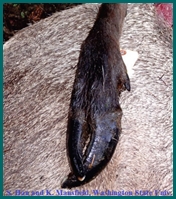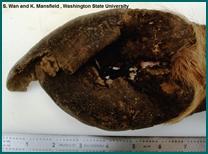|
|
|
| Risk Factor |
-
Most commonly observed in wild deer and moose (Alces alces)
(Cervidae), and bighorn sheep (Ovis canadensis).
-
Similar lesions found in domestic animals are
referred to as laminitis,
“founder” or “slipper-foot”.
-
Not often associated with
underlying systemic disease, but can be related to:
-
toxicity;
-
nutritional deficiency;
-
recurrent laminitis;
-
ergot toxicity;
-
fescue toxicity;
-
severe copper or selenium
deficiency;
-
other infectious
and toxic causes that may induce disease in blood vessels
(vasculopathy) in the distal limbs.
-
A genetic cause may be
considered as a remote possibility.
|
| Images |
|
Click on
images to enlarge. |
 |
 |
|
Malformed feet in
free-ranging cervids. |
|
| Signs and Symptoms |
-
Mild to severe overgrowth and marked deformity of hooves in
cervids
and bighorn sheep.
|
| Meat Edible? |
-
Discounting other disease conditions, meat from deer or sheep with
abnormal foot development is considered just as edible as that from
animals with normal feet.
|
| Human Health Concerns and
Risk Reduction |
-
There are no public health concerns associated with free-ranging cervids
or bighorn sheep that have abnormal feet.
-
Photos of feet showing abnormal growth or appearance can be submitted
to the nearest branch of the
British Columbia
Conservation Officer Service.
|
| Samples for Diagnosis |
-
Fresh, intact feet from affected animals.
|
| Further Reading |
|
|
|
|

